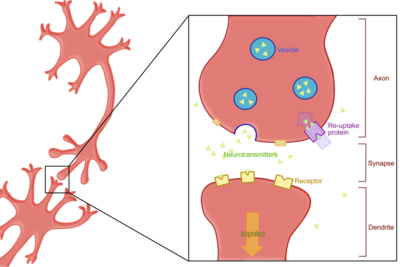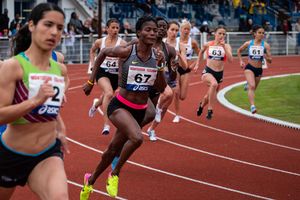Caffeine and Exercise
Introduction [edit | edit source]
Caffeine is a naturally occurring, central nervous system (CNS) stimulant and is the most widely taken psychoactive stimulant globally. This drug is most commonly sourced from the coffee bean but can also be found naturally occurring in certain types of tea and cacao beans. It is also an additive to soda and energy drinks. The primary goal of caffeine consumption is to combat fatigue and drowsiness, but there are many additional uses[1].
- Consumption is completely legal, socially acceptable, and is consumed daily by a large majority of the world population.
- Daily morning staples, such as coffee and tea, as well as soft drinks and energy drinks, contain caffeine.
- Ninety-percent of the adult population consider themselves daily coffee users, drinking on average two cups of coffee a day[2].
Many studies support the findings that caffeine enhances both physical and cognitive performances.
- A number of meta-analyses have demonstrated that caffeine’s ergogenic effects on exercise performance are well-established and well-replicated, appearing consistent across a broad range of exercise modalities[3].
- Several mechanisms work on different systems of the body to produce the overall enhancement of exercise performance that caffeine causes.[4].
Caffeine Sources[edit | edit source]
Most dietary caffeine is still consumed as tea and coffee, and the latter accounts for 55% of per capita intake in the UK (Scott et al, 1989). Despite (or perhaps because of) its ubiquity, caffeine is rarely thought of as a problematic drug. Doctors do not often ask patients about its use and enquiry into caffeine consumption is not usually included in psychiatric assessment.
On average,
- A cup of brewed coffee contains 100 mg of caffeine, compared with 75 mg for instant coffee and 50 mg for tea (Food Standards Agency, 2001);
- A can of Coca Cola contains 30 mg.
- Stimulant drinks such as Red Bull (80 mg of caffeine per can)
- Pharmaceutical caffeine may be bought over the counter (for example as ProPlus tablets)
- Also contained in numerous proprietary analgesics, cold and ’flu remedies, diet pills and diuretics; Anadin Extra, for example, contains 90 mg of caffeine per dose. [5]
It is assumed that it is safer for healthy adults when taken under 400 mg per day. The amount of this caffeine is roughly equal to consuming 4 cups of coffee.[6]
Neuromuscular Effects[edit | edit source]
- Ryanodine receptors (RyR)
A neuromuscular mechanism that aides in causing caffeine’s ergogenic effects is it's influence on the ryanodine receptors (RyR) in the sarcoplasmic reticulum of muscles[7].
- RyR functions as a calcium release channel in the sarcoplasmic reticulum, as well as a connection between the sarcoplasmic reticulum and the transverse tubule[8]
- Caffeine makes the RyR more sensitive to either the action potential (skeletal muscle) or calcium (cardiac or smooth muscle), thereby producing calcium sparks (microscopic release of calcium) more often (this is partially responsible for caffeine's effect on heart rate).
- Caffeine makes Ca2+ more readily available, which allows for stronger contractions of muscles than is typical at a given level of stimulation.
2. Nervous System.
The stimulant effect of coffee comes largely from the way it acts on the adenosine receptors in the neural membrane. Adenosine is a central nervous system neuromodulator that has specific receptors. When adenosine binds to its receptors, neural activity slows down, and you feel sleepy. Adenosine thus facilitates sleep and dilates the blood vessels, probably to ensure good oxygenation during sleep.
Caffeine acts as an adenosine-receptor antagonist. This means that it binds to these same receptors, but without reducing neural activity. Fewer receptors are thus available to the natural “braking” action of adenosine, and neural activity therefore speeds up. [9]
- Caffeine affects normal neurotransmitter release, increasing both the amount of noradrenaline (NA) and dopamine (DA) released in the brain during exercise[10].
- Dopamine has widespread functions, but a few of these include influences on motivation, cognition, reward, motor control, and mood[10]. Many studies have shown that an increase in DA release results in enhanced endurance[10] as it lowers pain perception.
- A study showed that muscle pain perception and perceived exertion was much lower in a group that received caffeine prior to resistance training, as opposed to when those same subjects were administered a placebo on a separate date[11]. When the individuals ingested the caffeine, they performed significantly more repetitions before failure than when they were given the placebo[11].
- Another study offered an explanation of the mechanism causing the reduced pain threshold. The researchers found that plasma ß-endorphin levels (an endogenous opioid analgesic) almost doubled after two hours of cycling with caffeine consumption, while the control group had no increase[7].
Research has shown that pure caffeine can help endurance athletes
- Run faster and cycle for longer.
- Footballers to sprint more often and over greater distances
- Basketball players to jump higher
- Tennis players and golfers to hit the ball with greater accuracy.
- Weightlifters lift more weight.
An increasing number of studies have also shown that coffee can be used as an alternative to caffeine to improve cycling and competitive running performance, and produce similar results similar to pure caffeine.[12]
Cardiopulmonary Effects[edit | edit source]
Caffeine is a natural stimulant that affects human mental health and body tiredness. However, one of the major side effects of taking directly or through caffeinated products can cause a rapid heartbeat and increase your heart rate.
- It is observed that caffeinated products can lead the person to an altered heartbeat (atrial fibrillation). Young people who consume energy drinks have been reported with atrial fibrillation.
- The effect on people having heart issues varies from one individual to another. Some people have a low impact of caffeine on their heart and can easily consume a large amount, whereas others have adverse effects and cannot take a cup of coffee on a daily basis. From a study, it was observed that limited heart failure patients consumed around 100 mg per hour for 5 hours and as an effect, their heart rate and rhythm stay normal[6].
The performance enhancement provided to the endurance athlete by caffeine is relates to the cardiopulmonary system.
- Caffeine causes bronchodilation, which likely leads to the increase in tidal volume and alveolar ventilation. As tidal volume and alveolar ventilation rise, an individual's respiration during exercise becomes more efficient; therefore, less exertion is required and the perceived effort needed to complete the activity is reduced[13].
- Caffeine ingestion prior to exercise lowers an individual’s rating of perceived exertion.
Despite there being strong evidence indicating caffeine's positive effects on the pulmonary system and lack of effects on heart rate, collectively the research remains inconclusive on the topics and, therefore, more experimental studies must be conducted.
Lipolysis[edit | edit source]
A mechanism by which caffeine positively effects athletic performance is by increasing the rate that lipolysis occurs[7].
- Lipolysis is the process human bodies use to break apart fats and produce ATP (our primary usable form of energy) to fuel our body. Each triglyceride (fat molecule) that is broken down produces approximately 300-400 ATP (depending on how many carbons from the specific fat are being used). The increase in fats being used to produce energy results in a decrease in carbohydrates used for that same purpose. This greatly increases efficiency because carbohydrate molecules produce far fewer ATP than triglycerides
Caffeine and Exercise[edit | edit source]
- It is well established that moderate to high caffeine doses (5–9 mg/kg body mass (bm)), ingested before and during exercise, increase endurance performance in laboratory and field settings. These doses are associated with increased heart rate and blood catecholamine, lactate, free fatty acid and glycerol levels in many subjects. However, side effects that often occur include gastrointestinal upset, nervousness, mental confusion, inability to focus and disturbed sleep.
- Lower caffeine doses (<3 mg/kg bm ~200 mg) taken before, during and late in exercise also increase endurance performance, and do not cause the physiological changes and side effects noted above in most individuals.
- Caffeine is also ergogenic in many forms of short-term high-intensity exercise and team stop-and-go sports, where anaerobic energy provision plays a significant role in performance success.
- The ergogenic effects of caffeine appear to result from antagonistic interactions with adenosine receptors in the central and peripheral nervous systems, increasing central drive and reducing the perception of effort and pain during exercise.
- The ergogenic effects of caffeine are maintained when administered in alternate forms other than capsules/tablets and coffee, including sports and energy drinks, gels, gum, bars and dissolvable mouth strips. Mouth rinsing with caffeine and aerosol administration is less likely to produce ergogenic effects.
- It is not yet clear whether genetic polymorphisms related to caffeine metabolism or adenosine receptor density can explain the inter-individual variability seen in the ergogenic response to caffeine administration[14]
References[edit | edit source]
- ↑ Evans SM, Griffiths RR. Caffeine withdrawal: a parametric analysis of caffeine dosing conditions. Journal of Pharmacology and Experimental Therapeutics. 1999 Apr 1;289(1):285-94.Available from:https://www.statpearls.com/articlelibrary/viewarticle/18756/(accessed 18.3.2021)
- ↑ Pesta DH, Angadi SS, Burtscher M, Roberts CK. The effects of caffeine, nicotine, ethanol, and tetrahydrocannabinol on exercise performance. J Nutr Metab. 2013;10(1):71. DOI: http://dx.doi.org/10.1186/1743-7075-10-71
- ↑ Pickering C, Grgic J. Caffeine and exercise: what next?. Sports Medicine. 2019 Jul;49(7):1007-30.Available from: https://www.ncbi.nlm.nih.gov/pmc/articles/PMC6548757/(accessed 18.3.2021)
- ↑ Kammerer M, Jaramillo JA, García A, Calderón JC, Valbuena LH. Effects of energy drink major bioactive compounds on the performance of young adults in fitness and cognitive tests: a randomized controlled trial. J Int Soc Sports Nutr. 2014;11(44). DOI: http://doi.org/10.1186/s12970-014-0044-9
- ↑ Winston AP, Hardwick E, Jaberi N. Neuropsychiatric effects of caffeine. Advances in Psychiatric Treatment. 2005 Nov;11(6):432-9.Available from:https://www.cambridge.org/core/journals/advances-in-psychiatric-treatment/article/neuropsychiatric-effects-of-caffeine/7C884B2106D772F02DA114C1B75D4EBF (accessed 18.3.2021)
- ↑ 6.0 6.1 Caffeine buff Caffeine and the heart Available from: https://www.caffeinebuff.com/caffeine-and-heart/(accessed 18.3.2021)
- ↑ 7.0 7.1 7.2 Tarnopolsky MA. Caffeine and endurance performance. Sports Med. 1994;18(2),109-25. DOI: 10.2165/00007256-199418020-00004
- ↑ Gene RyR1 Available from: https://www.ncbi.nlm.nih.gov/gene?Db=gene&Cmd=ShowDetailView&TermToSearch=6261 (accessed 18.3.2021)
- ↑ The brain from the top down Neurotransmitters Available from:https://thebrain.mcgill.ca/flash/i/i_03/i_03_m/i_03_m_par/i_03_m_par_cafeine.html (accessed 18.3.21)
- ↑ 10.0 10.1 10.2 Zheng X, Takatsu S, Wang H, Hasegawa H. Acute intraperitoneal injection of caffeine improves endurance exercise performance in association with increasing brain dopamine release during exercise. Pharmacol Biochem Behav. 2014;122:136-43.
- ↑ 11.0 11.1 Duncan MJ, Hankey J. The effect of a caffeinated energy drink on various psychological measures during submaximal cycling. Physiol Behav. 2013;116:60-5.
- ↑ The Conversation Coffee and exercise Available from: https://theconversation.com/can-coffee-improve-your-workout-the-science-of-caffeine-and-exercise-92366 (accessed 18.3.2021)
- ↑ Birnbaum LJ, Herbst JD. Physiologic effects of caffeine on cross-country runners. J Strength Cond Res. 2004;18(3):963-5.
- ↑ Sports science exchange caffeine and exercise Available from:https://www.gssiweb.org/sports-science-exchange/article/caffeine-and-exercise-performance-an-update (accessed 18.3.2021)










